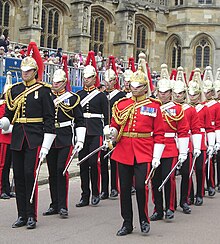Albert helmet

The Albert helmet is the current ceremonial headgear of the British Army's Household Cavalry.
History


Developed 1843 for the cavalry, base don the Prussian Army cavalry helmet. One observer called them "handsome, light and convenient".[1]
The United Service Gazette said "it is light, fits well to the head, produces and evenness of pressure and undeniably offers the best king of protection against a bullet or sword cut". All dragoon guard regiments had a black plume. The basic shape of the helmet has been retained in the full dress headgear ever since.[2]
Modified in 1865 as a result of experience from the Indian Mutiny and Crimean War, the resulting model is basiclly the same as that worn in modern full dress.[3]
The Kings Dragoon Guards changed their blakc plume to ref in 1857 and it has remained that colour since.[4]
Gilt with silver fittings for officers and brass with white metal for other ranks. It was not popular for strenuous work and the round kilmarnock cap was often worn on such occasions. When worn overseas the horse hair plume was said to have been plaited or removed.[5]
Replaced the bearskin caps previously worn, which were considered obsolete. Adopted first by the Household Cavalry and then by the heavy cavalry.[6]
The helmet remains in use, though less ornamental than the 1843 version.[7]
"The pattern of helmet adopted for Heavy Cavalry in 1847 followed the Prussian lines already aped by the Household Cavalry since 1843 , and was known as the Albert helmet ." [8]
Developed by Albert in 1842[9]
The Royal Horse Guards red plume no onion, 1st The Royal Dragoons black no onion.[10]
2nd Life Guards no onion, 1st Life Guards onion[7]
In current practice the two regiments differ in how they wear the helmet. The Blues and Royals wear the chin-strap under the chip and the Life Guards under the lower lip.[11]
Helmet is now white metal for all ranks. Both regiments now wear the same helmet plate (it has previously been distinguished by the colour of the field behind the cross).Rosettes holding the chin strap are slightly different and the Blues and Royals slightly longer becuase of their manner of wear. For officers Plume in life guards is horse hair and 18" long, Blues and Royals yak hair no onion, 17" long.[12]
Other ranks plume may be horse hair or nylon. 20" long in both regiments. Farriers in LG wear black plumes and in Blues and ROyals red.[13]
Helmet is worn in full dress, levee dress and ceremonial rehearsal dress only for officers.[14] For other ranks in full dress review order, guard order and front yard order only.[15]
Medical and veterinary officers wear a cocked hat in lieu of the helmet.[16]
Other ranks of the Mounted Band of the Household Cavalry wear the helmet in full dress (with the plumes of their regiments), except when parading in the presence of the royal family (in state dress) when the jockey cap is worn.[17]
References
- ^ Hobhouse, Hermione (1983). Prince Albert, His Life and Work. H. Hamilton. p. 46. ISBN 978-0-241-11142-0.
- ^ Mann, Michael (1993). The Regimental History of 1st The Queen's Dragoon Guards. Michael Russell [for] 1st The Queen's Dragoon Guards. p. 231. ISBN 978-0-85955-189-2.
- ^ Mann, Michael (1993). The Regimental History of 1st The Queen's Dragoon Guards. Michael Russell [for] 1st The Queen's Dragoon Guards. p. 261. ISBN 978-0-85955-189-2.
- ^ Mann, Michael (1993). The Regimental History of 1st The Queen's Dragoon Guards. Michael Russell [for] 1st The Queen's Dragoon Guards. p. 280. ISBN 978-0-85955-189-2.
- ^ Carman, W. Y.; Simkin, Richard (1982). Richard Simkin's Uniforms of the British Army: The Cavalry Regiments : from the Collection of Captain K.J. Douglas-Morris, RN. Webb & Bower. p. 69. ISBN 978-0-906671-13-9.
- ^ Carman, W. Y. (1968). British Military Uniforms from Contemporary Pictures: Henry VII to the Present Day. Arco. p. 132.
- ^ a b Melegari, Vezio (1969). Grandi Reggimenti. Weidenfeld & Nicolson. p. 66. ISBN 978-0-297-17646-6.
- ^ Rankin, Robert H. (1976). Military Headdress: A Pictorial History of Military Headgear from 1660 to 1914. Arms & Armour Press. p. 64. ISBN 978-0-85368-310-0.
- ^ Hoare, Nell; Marsh, Geoffrey; Commission, Great Britain Museums and Galleries (1990). Exploring Museums: The Home Counties. H.M. Stationery Office. p. 104. ISBN 978-0-11-290471-7.
- ^ MacLeod, Olaf (1986). Their Glory Shall Not be Blotted Out: The Last Full Dress Uniform of the British Army. Lutterworth Press. p. 6. ISBN 978-0-7188-2673-4.
- ^ Household, Joanna (1983). Debrett's Guide to Britain: Where to Go and what to See. Putnam. p. 88. ISBN 978-0-399-12855-4.
- ^ "Household Cavalry Drill and Uniform - a Freedom of Information request to Ministry of Defence" (PDF). WhatDoTheyKnow. 26 May 2020. p. 25. Retrieved 12 July 2021.
- ^ "Household Cavalry Drill and Uniform - a Freedom of Information request to Ministry of Defence" (PDF). WhatDoTheyKnow. 26 May 2020. p. 65. Retrieved 12 July 2021.
- ^ "Household Cavalry Drill and Uniform - a Freedom of Information request to Ministry of Defence" (PDF). WhatDoTheyKnow. 26 May 2020. pp. 21–23. Retrieved 12 July 2021.
- ^ "Household Cavalry Drill and Uniform - a Freedom of Information request to Ministry of Defence" (PDF). WhatDoTheyKnow. 26 May 2020. p. 62. Retrieved 12 July 2021.
- ^ "Household Cavalry Drill and Uniform - a Freedom of Information request to Ministry of Defence" (PDF). WhatDoTheyKnow. 26 May 2020. p. 34. Retrieved 12 July 2021.
- ^ Ryder, Thomas (1 June 1980). The Carriage Journal: Vol 18 No 1 Summer 1980. Carriage Assoc. of America. p. 2.
